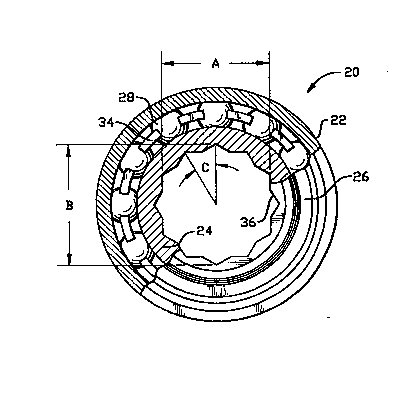Une partie des informations de ce site Web a été fournie par des sources externes. Le gouvernement du Canada n'assume aucune responsabilité concernant la précision, l'actualité ou la fiabilité des informations fournies par les sources externes. Les utilisateurs qui désirent employer cette information devraient consulter directement la source des informations. Le contenu fourni par les sources externes n'est pas assujetti aux exigences sur les langues officielles, la protection des renseignements personnels et l'accessibilité.
L'apparition de différences dans le texte et l'image des Revendications et de l'Abrégé dépend du moment auquel le document est publié. Les textes des Revendications et de l'Abrégé sont affichés :
| (12) Demande de brevet: | (11) CA 2098311 |
|---|---|
| (54) Titre français: | ROULEMENT A BILLES POUR ARBRE MULTI-COTES |
| (54) Titre anglais: | BEARING FOR MOUNTING ON A MULTI-SIDED SHAFT |
| Statut: | Réputée abandonnée et au-delà du délai pour le rétablissement - en attente de la réponse à l’avis de communication rejetée |
| (51) Classification internationale des brevets (CIB): |
|
|---|---|
| (72) Inventeurs : |
|
| (73) Titulaires : |
|
| (71) Demandeurs : |
|
| (74) Agent: | SWABEY OGILVY RENAULT |
| (74) Co-agent: | |
| (45) Délivré: | |
| (86) Date de dépôt PCT: | 1992-09-29 |
| (87) Mise à la disponibilité du public: | 1993-06-24 |
| Requête d'examen: | 1999-08-10 |
| Licence disponible: | S.O. |
| Cédé au domaine public: | S.O. |
| (25) Langue des documents déposés: | Anglais |
| Traité de coopération en matière de brevets (PCT): | Oui |
|---|---|
| (86) Numéro de la demande PCT: | PCT/US1992/008262 |
| (87) Numéro de publication internationale PCT: | WO 1993012353 |
| (85) Entrée nationale: | 1993-06-11 |
| (30) Données de priorité de la demande: | ||||||
|---|---|---|---|---|---|---|
|
ABSTRACT OF THE DISCLOSURE
A bearing (20) has an inner ring (24) coaxial to and rotatable relative to an
outer ring (20). A central bore (36) of the inner ring (24) accommodates a multi-sided
shaft in at least two positions that are angularly offset relative to each other. Each
position provides a different fit between the inner ring (24) and the shaft. A preferred
embodiment has a 12-pointed star-shaped bore defined by the superposition of twohexagons of slightly different scale, to accommodate a hexagonal shaft in either of two
positions. The second position provides a tighter fit between the bearing and the shaft
without requiring tighter manufacturing tolerances.
Note : Les revendications sont présentées dans la langue officielle dans laquelle elles ont été soumises.
Note : Les descriptions sont présentées dans la langue officielle dans laquelle elles ont été soumises.

2024-08-01 : Dans le cadre de la transition vers les Brevets de nouvelle génération (BNG), la base de données sur les brevets canadiens (BDBC) contient désormais un Historique d'événement plus détaillé, qui reproduit le Journal des événements de notre nouvelle solution interne.
Veuillez noter que les événements débutant par « Inactive : » se réfèrent à des événements qui ne sont plus utilisés dans notre nouvelle solution interne.
Pour une meilleure compréhension de l'état de la demande ou brevet qui figure sur cette page, la rubrique Mise en garde , et les descriptions de Brevet , Historique d'événement , Taxes périodiques et Historique des paiements devraient être consultées.
| Description | Date |
|---|---|
| Demande non rétablie avant l'échéance | 2001-10-01 |
| Le délai pour l'annulation est expiré | 2001-10-01 |
| Réputée abandonnée - les conditions pour l'octroi - jugée non conforme | 2000-10-16 |
| Réputée abandonnée - omission de répondre à un avis sur les taxes pour le maintien en état | 2000-09-29 |
| Un avis d'acceptation est envoyé | 2000-04-14 |
| Un avis d'acceptation est envoyé | 2000-04-14 |
| Lettre envoyée | 2000-04-14 |
| Inactive : Approuvée aux fins d'acceptation (AFA) | 2000-03-31 |
| Inactive : Renseign. sur l'état - Complets dès date d'ent. journ. | 2000-02-09 |
| Inactive : Dem. traitée sur TS dès date d'ent. journal | 2000-02-09 |
| Lettre envoyée | 2000-02-09 |
| Exigences pour une requête d'examen - jugée conforme | 1999-08-10 |
| Toutes les exigences pour l'examen - jugée conforme | 1999-08-10 |
| Demande publiée (accessible au public) | 1993-06-24 |
| Date d'abandonnement | Raison | Date de rétablissement |
|---|---|---|
| 2000-10-16 | ||
| 2000-09-29 |
Le dernier paiement a été reçu le 1999-09-10
Avis : Si le paiement en totalité n'a pas été reçu au plus tard à la date indiquée, une taxe supplémentaire peut être imposée, soit une des taxes suivantes :
Veuillez vous référer à la page web des taxes sur les brevets de l'OPIC pour voir tous les montants actuels des taxes.
| Type de taxes | Anniversaire | Échéance | Date payée |
|---|---|---|---|
| TM (demande, 5e anniv.) - générale | 05 | 1997-09-29 | 1997-09-15 |
| TM (demande, 6e anniv.) - générale | 06 | 1998-09-29 | 1998-09-10 |
| Requête d'examen - générale | 1999-08-10 | ||
| TM (demande, 7e anniv.) - générale | 07 | 1999-09-29 | 1999-09-10 |
Les titulaires actuels et antérieures au dossier sont affichés en ordre alphabétique.
| Titulaires actuels au dossier |
|---|
| THE TORRINGTON COMPANY |
| Titulaires antérieures au dossier |
|---|
| JAMES L. LAWSON |